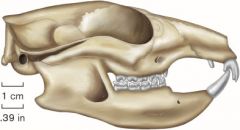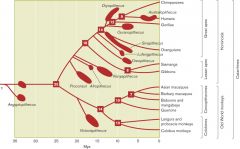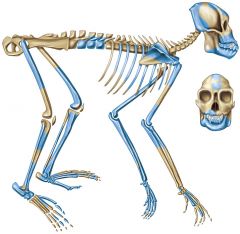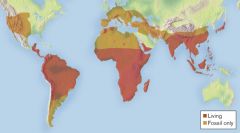![]()
![]()
![]()
Use LEFT and RIGHT arrow keys to navigate between flashcards;
Use UP and DOWN arrow keys to flip the card;
H to show hint;
A reads text to speech;
25 Cards in this Set
- Front
- Back
|
The arboreal hypothesis of primate origins explains that
|
grasping hands and feet were necessary for living in trees. |
|
|
As a corollary to the idea that primates emerged as an adaptation to an arboreal environment, Matt Cartmill proposed that
|
catching small prey was more important in primate evolution than living in the trees |
|
|
Robert Sussman’s angiosperm radiation hypothesis is based on the finding that
|
fruit was a newly available food source in the Cenozoic era |
|
|
Euprimates, the first true primates, consisted of the following two groups
|
Omomyids and Adapids
|
|
|
Higher primates most likely evolved from
|
Anthropoids
|
|
|
The Fayum primates in the Oligocene epoch were the
|
All of these are correct |
|
|
Which of the following is NOT a hypothesis for how anthropoids got to South America
|
African ancestors reached South America by using the Bering Strait between Asia and North America
|
|
|
While flipping through the channels, you stop on a television program about primate evolution. The host says that there is a 6-million-year gap in the fossil evidence between the latest Oligocene catarrhines and the earliest Miocene proconsulids, which could mean that primates disappeared from Earth and evolved anew some time later. Your roommate comes running when you start yelling at the television
|
"The resemblance between the Fayum catarrhines and the Miocene proconsulids in skull form and dentition suggests an evolutionary relationship, even if the direct fossil evidence isn’t there!"
|
|
|
Which of the following is unique to hominins
|
precision grip
|
|
|
The first primate fossil to be described by a scientist was recorded by
|
Georges Cuvier |
|
|
A valid criticism of the idea that anthropoids evolved independently in Africa and South America is that
|
there are striking similarities between Old and New World primates not only in phenotype but also in genotype
|
|
|
Eocene primates differ from Paleocene primates in the following way(s)
|
All of these are correct |
|
|
The common ancestor of all later catarrhines, Old World monkeys, and hominins was likely
|
Aegyptopithecus. |
|
|
From 12 to 8 mya, Dryopithecids were found in _____________ while Sivapithecids were found in _____________.
|
Europe; Asia
|
|
|
The largest primate that ever lived, named for its massive size, was
|
None of these is correct |
|
|
A valid criticism of the arboreal hypothesis of primate origins is that
|
the opossum is also an arboreal mammal but did not develop uniquely primate traits.
|
|
|
Your classmate, whose part-time job entails reorganizing the paleoanthropology lab on campus, asks you to take a look at a skeleton that she thinks is from a primate. After noting the absence of a postorbital bar, nails, and an opposable thumb, you tell her that
|
she should label this skeleton as a plesiadapiform rather than as a primate
|
|
|
While walking across campus, you overhear a guy telling his girlfriend that the origin of every human ancestor was in Africa. You stop him and explain that he is not completely correct because
|
based on the current fossil evidence, Asia could equally likely be the place where higher primates originated
|
|
|
Your biology instructor says in class that the fossil remains of primates from the Eocene demonstrate that they were nothing like the primates of today. After class, you argue with him, noting that
|
a variety of primate traits, such as convergent eyes, grasping digits, and a large brain, are common to both Eocene primates and those of today
|
|
|
The short calcaneus bone of Eosimias demonstrates that
|
All of these are correct
|
|

This skull indicates Plesiadapis was not a true primate because
|
All of these are correct |
|
|
This anthropologist is sweeping away layers of sand to
|
search for fossils in the Fayum Depression, Egypt. |
|

This phylogenetic chart of catarrhine origins indicates that
|
All of these are correct.
|
|

The skeletal anatomy of Proconsul indicates it can be classified as
|
an ape
|
|

The majority of primate species alive today reside in
|
the southern hemisphere |

